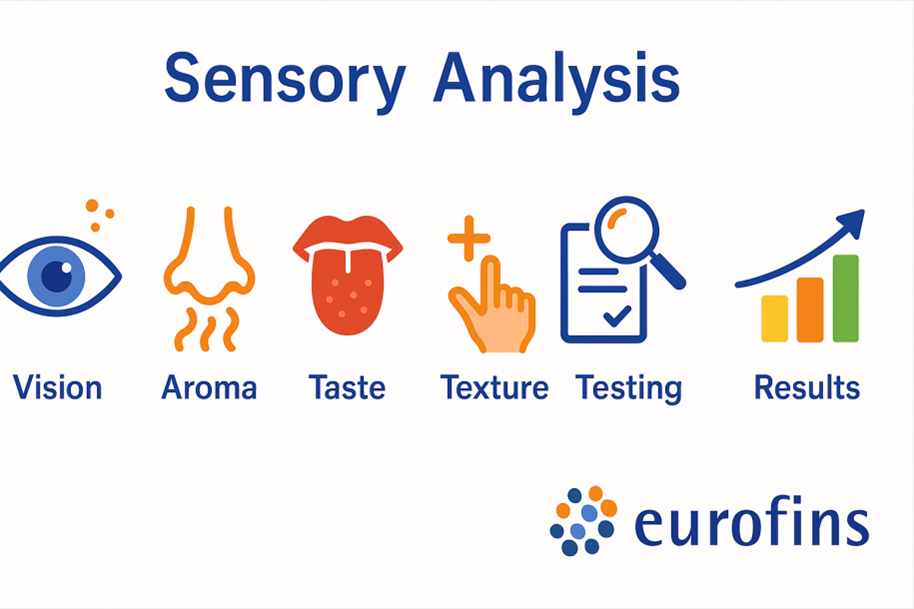Sensory Evaluation

What Is Sensory Analysis?
Sensory analysis is the scientific evaluation of food products using human senses—sight, smell, taste, touch, and hearing—to assess product characteristics and consumer perception. It is critical for quality control, product development, and brand differentiation.

At Eurofins, we leverage expert sensory panels, trained assessors, and advanced testing facilities to help clients understand consumer experiences with their products. Our methods comply with ISO, ASTM, and national standards, ensuring reliability, reproducibility, and market relevance.
Why Sensory Analysis Is Essential
Sensory testing is a cornerstone of food product success, providing insights that analytical chemistry alone cannot offer. Eurofins’ sensory programs enable you to:
- Ensure product consistency and quality across batches and manufacturing sites.
- Detect off-flavors, odor changes, or textural deviations due to processing, packaging, or storage.
- Support new product development and reformulation with consumer preference data.
- Correlate instrumental results (e.g., texture or aroma compounds) with sensory perception.
- Comply with regulatory labeling claims, such as “fresh taste,” “low bitterness,” or “improved mouthfeel.”
Types of Sensory Evaluation
Eurofins offers a comprehensive suite of sensory testing methods tailored to various business objectives:
|
Method |
Objective |
Typical Use Cases |
|
Descriptive Analysis |
Quantitative measurement of sensory attributes (appearance, aroma, flavor, texture). |
Product benchmarking, reformulation studies |
|
Discrimination Testing |
Determines perceptible differences between samples (triangle, duo-trio, paired comparison tests). |
Quality control, shelf-life validation |
|
Affective/Consumer Testing |
Evaluates liking, preference, or purchase intent among target consumers. |
Market research, new product launches |
|
Threshold Testing |
Identifies detection or recognition limits for specific flavors or odors. |
Ingredient substitution, contamination studies |
|
Temporal Dominance of Sensations (TDS) |
Tracks dominant sensations over time during consumption. |
Beverage and confectionery development |
|
Texture Profile Analysis (Sensory & Instrumental) |
Measures parameters like hardness, cohesiveness, chewiness, and creaminess. |
Dairy, snacks, bakery products |
Regulatory and Quality Framework
Sensory Evaluation Standards and Compliance
|
Jurisdiction |
Regulation/Authority |
Key Standards/Guidelines |
Application |
|
European Union |
ISO 8586:2012, ISO 13299:2016 |
Guidelines for sensory assessor selection and sensory profile creation |
Sensory laboratory accreditation and training |
|
United States (ASTM/ISO) |
ASTM E253:2022, ASTM E1871 |
Methods for difference and descriptive testing |
Product characterization and discrimination |
|
India (FSSAI / BIS) IS 6273 series (Parts 1, 2, 3)134 |
Food Safety and Standards (Labelling and Display) Regulations, 2020 |
Ensures sensory claims (“fresh,” “natural,” “flavored”) align with product characteristics |
Label verification and compliance |
|
Codex Alimentarius |
CAC/GL 50-2004 |
General guidelines for sensory evaluation |
International trade and quality validation |
All Eurofins sensory laboratories adhere to ISO/IEC 17025 and ISO 11136 quality management systems for sensory analysis.
Types of Sensory Testing Services We Offer
Eurofins provides both laboratory-based and real-world sensory testing, combining trained panels and consumer studies for robust insights:
- Descriptive Profiling: Quantitative attribute mapping by trained panels.
- Difference Testing: Identifying formulation or process-induced differences.
- Shelf-life Studies: Monitoring sensory degradation over time.
- Correlation Studies: Linking sensory data with analytical results (e.g., volatile compounds, texture analyzer readings).
- Claim Substantiation: Verifying sensory-based marketing or labeling claims.
How Our Sensory Testing Process Works
Eurofins follows a structured scientific workflow to ensure accurate, unbiased, and reproducible results:
- Sample Preparation: Standardized protocols to preserve sample integrity, temperature, and presentation order.
- Panel Selection: Recruitment and training of expert or consumer panels per ISO 8586 guidelines.
- Test Design: Customized design based on product type, objective, and methodology.
- Evaluation: Controlled environmental conditions (light, temperature, odor-free booths) for unbiased assessment.
- Data Analysis: Statistical interpretation using ANOVA, PCA, or preference mapping.
- Reporting: Comprehensive analytical and interpretive reports with actionable insights for product optimization.
Who Needs Sensory Testing?
Our sensory analysis services are tailored for:
- Food and beverage manufacturers developing or optimizing recipes.
- Flavor, fragrance, and ingredient suppliers assessing performance.
- Quality assurance and R&D departments ensuring batch consistency.
- Consumer goods companies conducting preference or market studies.
- Packaging and storage researchers studying shelf-life impacts.
Common Issues We Help Clients Solve
|
Issue |
How Eurofins Helps |
|
Inconsistent sensory quality across production |
Routine discrimination and profiling tests to standardize batches |
|
Customer complaints about taste or odor |
Root-cause identification and off-flavor characterization |
|
Reformulation or ingredient change validation |
Sensory comparison and consumer acceptance studies |
|
Shelf-life reduction due to packaging |
Sensory degradation analysis over storage duration |
|
Product underperformance in market tests |
Consumer insights and sensory preference optimization |
Case Study: Enhancing Consistency for a Snack Brand
A leading snack manufacturer partnered with Eurofins to address consumer complaints about inconsistent flavor intensity. Our trained sensory panel conducted descriptive analysis across five production batches, identifying variability in seasoning distribution. Based on our findings, process adjustments were made to ensure uniform coating. Follow-up consumer testing confirmed improved flavor perception and satisfaction, leading to a 20% increase in repeat purchases.
Why Choose Eurofins for Sensory Analysis?
- Global network of ISO/IEC 17025-accredited sensory laboratories.
- Expert sensory scientists, statisticians, and consumer research specialists.
- Access to diverse trained and consumer panels across demographics.
- Integration of sensory data with chemical and instrumental analysis for comprehensive insights.
- Flexible study formats—in-lab, home-use, or virtual panels—to meet business needs.
- Discover how consumers experience your product with Eurofins’ sensory testing solutions.
- Contact our sensory experts to design a customized evaluation study.
- Partner with Eurofins to optimize product performance, consistency, and consumer appeal.
Enquire now: https://www.eurofins.in/food-testing/enquire-now/


